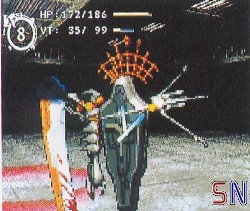
 |
|
Developer Sting is best known for its recent Dreamcast RPG, Evolution. But before that light-hearted adventure romp came another title with a far more serious tone: Baroque. This perversely unique dungeon crawl has a tone unlike any other game before or since. Originally released for Sega's ill-fated Saturn, a recent PlayStation port makes a U.S. localization once again possible. Gamers looking for something dark, different, and strangely wonderful should cross their fingers for an English port. The title "Baroque" comes from the Portuguese word "barroco," meaning "crooked pearls." It refers to an architectural movement in 17th and 18th century Europe that relied on magnificent structures and over-adornment and decoration. It typically refers to an excess of decoration or design. In the world of the game, however, the word has taken on a second meaning: "crooked fantasy." Stranded and isolated in a desolate future, surviving humans turn to "Baroque" imaginings to survive. Like the title of Terry Gilliam's film Brazil, "Baroque" refers not to something found in the game, but to a state of mind.
The world of Baroque is set after a worldwide disaster, the "Great Heat Wave," has eliminated most of the world's population. Bizarre religious cults, killing demons called Ikei, and strange murders have spread across the land. Many of the human beings who survived the disaster have reverted to some other, more primal state. The people wait in vain for a hero to arrive and save them. In Sting's own words: "Everything got crooked. And the earth collapsed." The Tower of Nerve stands forbodingly over this wasteland. This tower is organic, its shape and passageways constantly shifting and churning; its corridors filled with the Ikei. Some say that the Tower caused the Great Heat Wave; others say that only it can repair the damaged world. But no one knows why or how. Into this scenario is thrust the player: an amnesiac young man filled with an overpowering sense of guilt and sin. An angel appears to him and tells him that only straightening the world can appease his guilt. Faced with this decree, he heads to the Tower of Nerve. Needless to say, spunky 14-year-old adventurers and their cute rodent sidekicks are nowhere to be found.
The world of Baroque is a mystery waiting to be solved. The game is set around and inside the Tower of Nerve. The Tower is explored from a first-person, 3D perspective; each time the player enters the Tower, the passageways and item placement changes. Items have a variety of different uses; they can be used, drunk, thrown, combined, and more. Unfortunately, many items are unidentified. Proper item usage is the only way you can hope to survive the Tower. The player has two "life" statistics: HP and Vitality. HP, or Hit Points, behave like normal RPG energy. Vitality, on the other hand, is continually draining. Items can slow the rate of attrition or temporarily reverse it, but the threat of exhaustion is constantly present. This adds a sense of urgency to your mission; if you don't keep moving, you'll die before you reach the end. Not that death is permanent in the world of Baroque. Sure, you find yourself outside the Tower, and much of your progress is lost. But it's not restarting so much as ressurection. Your character may remember something new after being brought back from the dead; NPCs may change what they say to you; the Tower itself may open up to reveal new secrets. Each death brings you closer to the truth. Each new "life" gives you a new perspective, and a new piece of the jigsaw puzzle that is the game's story.
Baroque's twisted world is brought to life (or is that death?) via impeccable design and sound production. The design draws on Christian mythology, Tarot mysticism, and the biomechanical nightmares of H.R. Giger with equal aplomb. The graphics, a mixture of traditionally drawn and CG-renderings, adequately convey the Tower's claustrophobic passages and the "crookedness" of the world. Also of note is the involving soundscape. Masaharu Iwata, music composer of Tactics Ogre and Final Fantasy Tactics, has created a moody, ambient, and terrifying score similar to Stanley Kubrick's The Shining or Konami's Silent Hill. Environmental noise such as your character's own irregular heartrate, labored breathing, and gasps of pain and shock only add to the paranoia. Baroque isn't a title for everyone. Many gamers weaned on super fun happy anime quests will take one look at Baroque's nihilistic future and run cowering in fear. But gamers looking who like their subject matter dark, twisted, and truly mature should keep an eye on this promising project -- and its prospects for a North American release. Preview by Andrew Vestal, GIA. |
|
||||||||||||||||||||||||||||||||||||||||||||||



